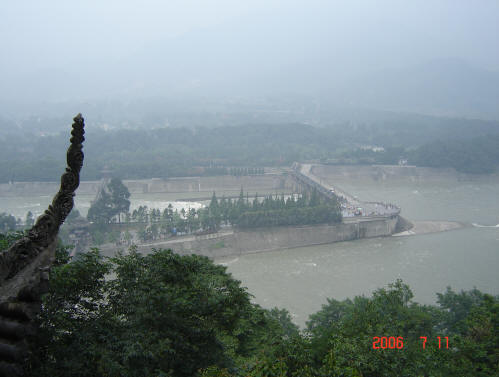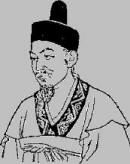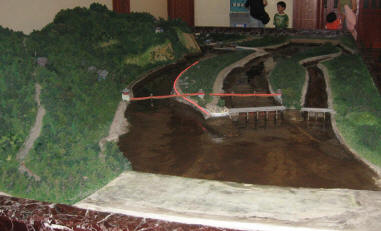
Dujiangyan Dam

Dujiangyan Dam
Stop 8: Dujiangyan Irrigation Project "Taming the Dragon"
Focus Question:
How does the Dujiangyan Irrigation
Project utilize the resources of the Yangtze tributary, the Minjiang River, and
also protect the Chinese from flooding?
Portfolio Question: Why do people live and
move where they do? & How has technology affected people's lives?
History:
(Watch this video clip about this irrigation project: Engineering an Empire: China Clip) Dujiangyan is the oldest and only surviving no-dam irrigation system in
the world
and has been working for 2,250 years. The
Qin Dynasty (778 - 207 B.C.E.)
conquered the people who lived in the Sichuan area, known as the
Shu dynasty in
316 B.C.E. The Qin emperor sent the great civil administrator,
Li Bing, to
govern the province. When he witnessed the flood damage caused by the Minjiang
River, he realized he needed to protect this very agriculturally rich area by
creating the Dujiangyan Irrigation Project.
Without modern equipment, the army of workers under Li Bing and his son's supervision cut a path
through mountains on the banks of the Minjiang River by heating and cooling rock
to break it up. The ingeniousness of the system includes a
dike in the middle of
the river to help reduce the amount of silt that flows into the aqueduct. The
spillway allows the excess water to continue down the Minjiang River in order to
prevent the flooding of the Chengdu basin. It has been renovated over time by
different dynasties and governments. But, since the irrigation project was
completed, Chengdu has been free of flooding.
 Li Bing
""Dredge the riverbed when the water is deep and build low dykes when the water
is low".
Li Bing
""Dredge the riverbed when the water is deep and build low dykes when the water
is low".
Interesting Note: The conquered Shu people
of the area were very superstitious and believed that the Minjiang was really a
dragon deity. So, "the first thing Li Bing did was setup a temple to honor the
Min dragon deity. He then offered his own two daughters as brides to the deity.
But first he set up a large nuptial banquet along the river. He offered a toast.
But the deity did not drink his glass of wine. Deeply offended, Li Bing runs off
sword drawn. Two bulls prepared in advance were then seen by the crowd fighting
along the river bank. Symbolically, this was Li Bing in a duel with the deity.
Li Bing returns to the scene sweating as if in battle and calls for assistance.
One of his lieutenants ran up to the bull that Li Bing had pointed out was the
deity and killed the bull. The river spirit was subdued." (Source)
A: Fish Mouth. B: Outer River Dike (Jingang
Dike). C: Inner River Dike (Jingang Dike). D: Inner River.
E: Outer River. F: Mingjiang
River. G: Feishayan (Drainage
Dam). H: Renzi Dyke.
I: Bottle Mouth. J: Lidui
Park. K: Baizhang Dyke
(Dike). L: Erwang Temple.

Sketch drawing of the Project
Pic of model looking straight on at Fish's Mouth
 This is looking down from Erwing Temple(L). You can see
the Minjiang River flowing from right to left here with the Fish's Mouth(A)
separating/diverting the river.
This is looking down from Erwing Temple(L). You can see
the Minjiang River flowing from right to left here with the Fish's Mouth(A)
separating/diverting the river.
 Fish's Mouth (A) - This part separates the water flow to
either the Outer(E) or Inner(D) river.
Fish's Mouth (A) - This part separates the water flow to
either the Outer(E) or Inner(D) river.
 This is the Anlan Cable Bridge that crosses the Inner(D)
river, which is also deeper than the Outer(E) river, so that water will always
flow down this one to feed the irrigation system for farming.
This is the Anlan Cable Bridge that crosses the Inner(D)
river, which is also deeper than the Outer(E) river, so that water will always
flow down this one to feed the irrigation system for farming.
 This is a dyke in the Outer River(E), diverting water.
This is a dyke in the Outer River(E), diverting water.
 Before cement, the Chinese used these structures made of
bamboo and rocks to make dykes in the water.
Before cement, the Chinese used these structures made of
bamboo and rocks to make dykes in the water.
 Nowadays, Dujiangyan has been renovated with these modern
spillways. Overall, the original structure is still working.
Nowadays, Dujiangyan has been renovated with these modern
spillways. Overall, the original structure is still working.
Photo Gallery:
Dujiangyan Irrigation Project
Websites for More
Information:
Wikipedia -
Dujiangyan Irrigation Project
Back to Yangtze River Web Tour Main Page